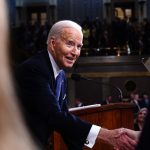It was a cruel twist of fate, that twisting of Steph Curry’s ankle.
Because for a moment, between the start of Wednesday’s game against the Milwaukee Bucks and the first 44 minutes of Thursday’s matchup with the Bulls, the Warriors looked like the team maximizing its potential.
The squad was healthy. The rotations were right. The Warriors looked like they knew what they were doing out there on the court. You would have been forgiven for letting your imagination run with the possibilities.
But you need to pull it back now that Curry is on the shelf.
The Warriors’ superstar twisting his ankle, again, throws a Warriors season that was starting to come into focus back into the blender.
And now the Warriors’ season isn’t just on the line — the franchise’s future is, too.
As of Friday morning, we do not know how long Curry will be out. Given that we’ve seen him twist his ankle countless times before, it’s fair to guess that he will miss some time, though. A week, two, more? We’ll see.
But time is the one thing the Warriors do not have.
Not if they want to find that elusive “other level” they believe they have.
Not if they want to avoid the play-in tournament.
The truth has always been so obvious it can go without saying, but let’s say it anyway:
These Warriors are nothing without Curry.
That sum-of-all-parts mentality Steve Kerr preaches? Well, there’s a critical part to that machine, and he wears No. 30.
The Warriors’ offense revolves around him. An entire style of basketball evolved from him.
This team cannot progress without him. At best, they can tread water.
Related Articles
Warriors’ season hinges on Steph Curry’s uncertain right ankle injury
Warriors lose nail-biter to Bulls as Steph Curry leaves game late
In emotional return, Bob Myers reminds Warriors of his lasting impact
Warriors rise to the occasion with complete effort in convincing win over Bucks
A new goal for the inscrutable Warriors — just be better than the Lakers
You cannot prepare for injuries, but this threat always loomed for the Warriors.
With a lineup constantly in flux, they built a team that couldn’t jell for the first four months of the season.
They finally found something at the end of January: Draymond Green at center and, not long after, rookie Brandin Podziemski as Curry’s running mate in the backcourt.
Of course, the lineup couldn’t possibly be constant. It’s the NBA. Andrew Wiggins was away from the team for four games, returning for Wednesday’s game. But the results of the switch were unimpeachable. The Warriors, after Thursday night’s loss, are 14-6 since Jan. 27, Green’s first day back in the starting lineup following his mid-season suspension. Their ideal starting lineup is 6-2.
The Warriors have 20 games remaining this season, with only eight of those games at home. No matter how narrow or loose your definition, this is the home stretch, and it features three games with the Mavericks (just above the Warriors in the standings) and two with the Lakers (just below).
The best-case scenario for the Warriors is that Curry is on the shelf for a few games, and the Warriors do well without him (the Dubs’ play amid Curry’s knee injury last season would be a good example of that.) He returns to a team that has not picked up any more injuries, and there’s enough time between that point and the end of the regular season (April 14) to re-establish this team’s best form.
This best-case scenario still features the play-in tournament. In all likelihood, the Warriors will still have to win two games to advance into the “real” playoffs.
That’s the same as the worst-case scenario.
But there are larger implications with come with the second option.
If we have seen the last of Curry for a while; if we have already seen the best basketball the Warriors have played this season, there are serious repercussions for the future of the team.
Warriors ownership has made no secret of its goal to not pay the league’s luxury tax next season.
And that makes sense. According to Salary Swish, the Warriors have paid $185.2 million in luxury tax this season — for a play-in tournament team. I’m no financial advisor, but I don’t think Joe Lacob and company are getting a great return on their investment there.
With the players they have under contract next season—a list that doesn’t include Klay Thompson, Chris Paul, or Gary Payton II—they’re already $2.6 million over the tax threshold. If Payton accepts his $9.1 million player option—and he should—you can add that to the tally.
Even if the Warriors let Paul walk and re-sign Thompson to a contract that pays him 50 percent of his current deal, you would have a team that would be well over the second luxury tax apron again.
Which brings us to the big question — one that needed to be answered in the final 20 games but might become a forever mystery: Is this a team worth the cost of running back?
The Warriors needed these final weeks of the season to make a statement — to tell ownership and the league that this team might have struggled early but is now ready to contend in a loaded Western Conference.
That can’t happen without Curry. And even a minimal absence knocks the short and long-term trajectory of this team off-kilter.
That’s what happens when the gravitational force that holds this whole operation together — the star of stars in a league defined by them — goes away.
At some point, Curry will return. In the meantime, the Warriors are going to make a mess. That’s unavoidable.
And, as he has been asked so many times before in his career, Curry will eventually be asked to clean it up.
We’ll see if he has enough time to do it.


